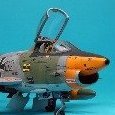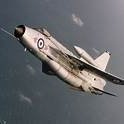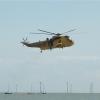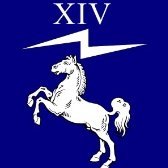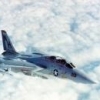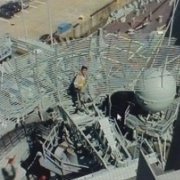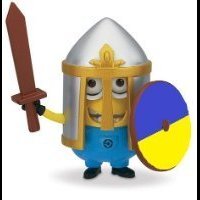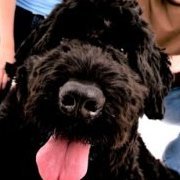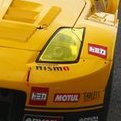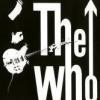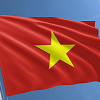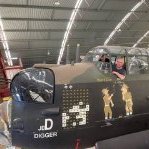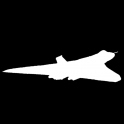Leaderboard
Popular Content
Showing content with the highest reputation on 27/02/22 in all areas
-
Hi all, again... Here are some pictures of my TA-7C CORSAIR, in Hellenic Air Force duty. It’s a kit from Hobby Boss, in scale 1/48. I’ve included Aires detail set for the cockpit. The ejection seats SJU-11/A & SJU-12/A of the kit΄s cockpit are replaced with two seats from Aires detail set. Also I΄ve included Eduard Detail Set for A-7E and Aires Detail Set for Wheel Bay. I scratch-building the tail section and the brake chute housing, the air starter receptacle panel, the gun gas purge door and the pilots steps ladder in open position left rear of the fuselage, the battery inspection panel rear right of the fuselage and below a strike camera K18B and a central speed break. Also I corrected the air intake shame from the model. The model is painted in “SEA” camo (FS 34102), (FS 34079), (FS 30219) and (FS 36622), using colors provided by the ModelMaster and it finished with extensive weathering. Decal sets are from Icarus Decals, representing a TA-7C (336 squadron) in Hellenic Air Force duty. I hope you enjoy my model. Happy modeling to all! Giannis Doxas47 points
-
Hi all. This is Tamiya's excellent 1/48 F-16C with some added aftermarket goodies. The cockpit, wheelbays and exhasust are from Aires, the wheels from Wheeliant, the pitot tube from Master and the decals are from Speed Hunter Graphics. The kit went together very well as you might expect and even the Aires cockpit didn't fit all too bad, considering the reputation of this brand. The model was painted with MrHobby acrylic paints, which was airbrushed in very thin coats over a black primer from Alclad. Washes made from Abteilung 502 oilpaint and white spirit were brushed over the whole model and excess wash was wiped off after a few minutes, giving the model a nice, dirty look. Thanks for watching.41 points
-
Good morning all, I thought I'd share a recent model of mine that I've been working on for a while - a conversion of the Tamiya 1:32nd scale F-4J to a UK version with RR Speys. It's a conversion I have long wanted to do, and when I sourced a set of 3D printed Spey cans along with a decal set from Cutting Edge, I was good to go! The conversion is quite involved, and includes widening the intakes as well as dropping the back end a little to accommodate the larger Spey afterburners. I took a couple of pictures of the process when widening the front, but didn't get around to photographing the back end unfortunately! There was also the small doors on the rear fuselage to add, as moving the auxiliary doors on the lower fuselage forward. I also had to source some after market ejection seats the Brit Phantoms used a different seat to the US examples. And here's the finished model, painted as an FGR.2 of 41 Squadron based at RAF Conningsby in the early 1970s: I'm really pleased with how the conversion went and it's nice to now have a very rare model (in this scale!) in my collection. Best regards, Rob26 points
-
Afternoon all, I've had a bit of a hiatus from this forum in recent times, but I've still been plodding on! I thought it was time I shared some of what I've been up to, and Tornados have featured prominently. I hope you enjoy them! Revell 1:48 Tornado F3 43 sqn RAF Leuchars IMG_5286 by Craig Scott, on Flickr Revell 1:48 Tornado F3 111 sqn RAF Leuchars IMG_3032 by Craig Scott, on Flickr Revell 1:48 Tornado GR4 617 sqn RAF Lossiemouth IMG_2972 by Craig Scott, on Flickr Revell 1:32 Tornado GR4 XV centenary jet IMG_1117 by Craig Scott, on Flickr Any comments or queries welcome, hope you enjoy them!21 points
-
My new, Airfix, finished model. Bristol Bulldog, 1/72 scale. Boxed camo, aircraft K-2158, A flight, 19 Sqn RAF. I invite you to view photos.19 points
-
Our youngest daughter bought me this one Xmas a few yrs back. What a great little kit. Can't remember where the cockpit detail came from, think I may have bought an etch set? Our eldest daughter got me the Airfix Vampire which was equally as good.15 points
-
This one was a bit of an experience, the first time I've ever done anything like this. The Revell kit with the lighting kit from Tyridium Models. A really enjoyable project! IMG_3847 by Craig Scott, on Flickr IMG_3843 by Craig Scott, on Flickr IMG_3819 by Craig Scott, on Flickr14 points
-
Whenever you were around airshows in the 80s there would be a Jet Provost somewhere. Rarely the star but always around. To be honest I really intended to do a T5 but spotted this Fly T4 kit. Now most T4s were gone by the 80s, but not at RAF Shawbury. They carried on in glorious red & white until 89. The kit doesn’t include that scheme, but does include XR673 in her retired grey scheme, so a little switching about of decals an she was backdated. Also had her extra under wing ariels added from her Shawbury days. Got her out in a little sunshine today And with my other two red & white jets - Chippie still to come Thanks for looking!14 points
-
My recent project has been a peculiar self inflicted challenge, which very much raises questions of “why start from there”. I would venture this whole business raises questions of “why” because her indoors says it every week. I had two Airfix Swordfish models in the stash. I decided my challenge was to build the original 1958 kit into the best standard I could that compared favourably with the 2012 version. Having the later kit (still unbuilt) was invaluable on my bizarre mission. Why? Well, why not; but what tipped me over the edge was the ridiculously good fuselage dimensional accuracy and gross features of the old kit. Seeing built up photos of the original model convinced me there was something very authentic emanating from the work of the 1958 die-maker. Sure, the wing section is bonkers, the trailing edges are dire, and crude doesn’t come close to describing the interplane area. There are only two dozen pieces in the kit, but I take my hat off to Bert (or George) who worked those dies just four years after rationing ended in the UK. I had some cheats, but not many. I bought from Airfix the arrestor hook, the landing lights and the exhaust manifold of the 2012 kit. I also bought a beautiful Pegasus motor. My total purchase of aftermarket is listed later. So, the journey was this. I went for the Airwaves photo-etch which I deduce is meant for the old kit. I know we all take a principled stand of no criticism, but hey, I’m going for it. Hannants/Xtradecal are brilliant, Airwaves is not. Three times I have sucked it up and bought their PE (Sea King, EE Lightning, Swordfish). The parts are simplified (ok) but largely the wrong size and shape (not ok). How is it “simplified” to have to modify a PE part that is badly wrong? It’s worse than searching the floor for a tiny PE part that is accurate. The PE set gave me a couple of useful parts for the cockpit, the l.e. slats, and the oil cooler (after some modifying to make it a Mk1). Overall the PE foray did not deliver much. Instead I whittled away with the fuselage to create all panel lines and fasteners, and deepened the ventral fuselage for a hook housing. I filled the waste bin with dust from filing the wings/tails to give 10% thickness, near sharp trailing edges and I recreated the ribbed effect. All struts/cabanes were scratch made from plastic, brass or steel, as were the undercarriage struts. Having copied the principles of the 2012 kit on these parts, it assembled into a pretty damn good look. As I said, having a decent fuselage was the cornerstone. Fuselage still looking a bit basic, but panel lines appearing I needed the rear of the Townend Ring (having bought the manifold from Airfix). I drilled out the original single piece engine/ring with a 19mm drill (okay, I know no one else is ever going to do that between now and the asteroid impact, but the tip is there if you want it). I achieved a really nice ring that exceeded my imagination and it fitted the manifold very well. I fashioned the rather complex torpedo crutch from brass. I made compass mounts and a single compass from brass. I built a gun mounting from spring steel and brass, but alas I could only get motion in the fore-aft swing of the ring mount. The control lines for the empennage were made from 0.1mm brass. Fiddly, yes, but not the nightmare that I expected. Is there any steel micro-rod made in this size? If so that would be better. Beautiful Radial Engines and Wheels Pegasus, plus part of Townend rear ring Rear of motor. I made the inlet manifolds from brass rod My list of aftermarket is: Airwaves PE set AC72-178 Radial Engines & Wheels REW72002 Pegasus (the most amazing thing; view it under x10 and see every single cooling fin. I really do not know how they made it. Sweet, as the younger ones say.) Miniworld A72 29 Vickers K machine gun. Beautiful! Miniworld A72 31a Browning 30 cal machine gun (used only the barrel to emulate the real forward facing gun barrel) SBS Model 72 050 Wire Bracing set, which is for the 2012 kit Quickboost QB 72 363 Swordfish Mk1 exhaust Eduard CX316 1/72 Windscreen Mask (however this was not used because I opted to use the screen from Airwaves which required acetate glazing) Flightpath 1/72 RAF/RN Torpedo and Handling Trolley (18” torpedo). This is a lovely model in its own right, and I admit to not making it yet! Xtradecal X72-147 stencil decals. Lovely decals. I do wish stencil makers would back off the darkness and crispness of stencils. I once worked in an aircraft paint shop and even fresh stencils have a dodgy Friday afternoon look. I chose an iconic (or old fashioned word “common”) scheme from 820 Squadron in 1941. The demarking decals were the Airfix originals from the 2010ish FAA set of Swordfish, Wildcat, Seafire from whence the 1958 kit came. These were good quality and usable. I managed to forget to varnish one side roundel and 2Q code and then I stuck masking tape on it. Disaster! I ripped the roundel in two and wrecked the top half of 2Q. The 2Q code was black with a white highlight and irreplaceable. I wasn’t going to be beaten and I rebuilt the decal out of white and black decal sheet. I actually did far better than I feared, and I think you cannot spot the repair without magnification. The paint was all Sovereign Hobbies. I bought some particularly fine brown electrical cable to give me the cockpit edge soft landing for the pilots shoulder. For a moment let’s think about three young men taking off from Ark Royal in a sickening mid Atlantic gale, at night, heading for a presumed Bismarck 100nm away, and then finding their way back to relative safety on the flat-top. With a compass and morse comms, but no stars because the weather was invariably foul. Oh, and a couple of thousand people were trying to kill them too. I read about assembling the lower surface of the upper wing (and oppo on the lower wing) to allow the box structure to gain strength. It worked well. The beefy faired V strut was made from scratch You can say there is one less unbuilt nasty old Airfix original Swordfish in the world. Whilst that might have been in my mind at one stage, I now think what a brilliant guy George (or Bert) was. I write this believing that no one is ever going to do this again; job done! My particular struggles were with the windscreen. The original glazing piece was unusable. The 2012 windscreen did not fit the fuselage coaming at all. The Airwaves windscreen frame is completely the wrong aspect ratio and is not tall enough, but it did fit the fuselage (as it was intended). Despite heroic efforts with the wing section it still looks rather blunt, but that is not easy to spot. The top and bottom parts of each upper and lower plane do not fit together well and I wish I had done more fettling on this before the big cement-fest occurred. I camouflaged the join with weathering effects. It was impossible to cut out the wing tip hand-holds, so a noticeable shortcoming there. The wire bracing stage was fun (not!) but I had pre-drilled wing surface holes and taking it carefully really paid off. I cleverly forgot all about the lower wing landing lights (not present at all in the 1958 kit) until the build was almost finished. I managed to cut the wing without destroying the struts and wires, but I would have had better seated lights if I had cut the wings before assembly. I tweaked all the control surfaces a few degrees and set the ailerons 5deg down to replicate the pseudo flap setting. I used a brass wheel from my 00 gauge loco modelling for the flap setting control. I wasn't too fancy on the cockpit detailing, and it really was a waste of time to work on the front cockpit. The weathering on the fuselage sides was mainly finger prints! The top of the 2Q just shows the repair. For reference material I purchased the: Aeroguide Classic 4, but this is not worth having because it is simply poor b&w photos of preserved aircraft that have unoriginal features; Swordfish MkII and MkIII in Detail, Wings and Wheels Publications R068, which is also photos of museum aircraft but presented extremely well. The best book by far, and up there with any aircraft reference book I have ever bought is Swordfish From the Cockpit No10 Payne & Donald. It has 200 high quality pages of mainly photos (guessing 300+) with captions and really well edited personal recollections. It does not try to be a technical description, but the sheer quantity of photos and informed captions gives the most impressive insight into the beloved beast. This all came at the give away price of £7.45 and free p&p from WorldofBooks. It was worth multiples of that. Even if you are not intending to build a model, this book would add well to any aircraft library. Overall this has been one of the most satisfying kits I have made, simply because of the amount of challenge I took on. I hope my random scheme of picking stash kits does not deliver the 2012 Swordfish any time soon though. Kitchentable PS we are having a new kitchen in February and I will have an almighty battle retaining evening rights to the new kinked peninsular arrangement. Wish me luck.14 points
-
After 30 years of thinking then over 4 years learning CAD and 3d printing I finally have produced a personal memory capsule , along with a few 1/35 prototypes on the way, a 1/24 Triffid detachment complete with full interior of this BAOR Royal Signals detachment usually deployed as part of Divisional and Brigade Armoured headquarters. Only light weathering as these 'panzers' were well maintained and had a critical inspection schedule because of the radio installation. I doubt if one of these was ever ploughed up and down the pylon line on the Soltau-Luneberg Training Area. The donor kit is the excellent Kit Form Services FV432. Enjoy the images.13 points
-
Dear All, here is my last hasegawa BF109 G4 trop kit is painted with gunze acrylics wheatering is done with enamel filter and pigments13 points
-
I'm not a big fan of the Kittyhawk kit so this was my best option, the Airfix kit with some aftermarket and a bit of scratchbuilding. Especially with the intakes replaced though it still builds into a decent rendition IMG_9701 by Craig Scott, on Flickr IMG_9685 by Craig Scott, on Flickr IMG_9682 by Craig Scott, on Flickr12 points
-
Hello folks, This is the now old Hasegawa F-14, the fitting was terrible, putty was extensively used. The Iran Air Force still fly the tomcat but nowadays it looks more like a flying museum rather that a lethal weapon. Anytime Baby!12 points
-
Good evening boys and girls The painting process on the big Sunderland is now more or less complete - since the last pictures I've added the upper wing insignias and given the model a couple of coats of flat varnish to kill the high gloss Xtracolor paints provide - great for decaling but not so for a WWII-era flying boat! After that, I made and added the radar aerials for the fuselage sides: As well as the one above the flightdeck: The canopy has been unmasked and the good news is it survived the painting process unscathed: I have made the early-style exhausts from Evergreen tube, bent very carefully over the toaster! They were then sprayed with Humbrol burnt steel and added to the collector rings, which have also been painted according to references: I've started the weathering of the upper surfaces by blowing some various greys back from the exhausts: I've also sprayed on the distinctive water marks on the lower hull using various browns as seen on period photos: And here's where we're at now: The to-do list is certainly getting shorter and I'm now entering the home straight, although there's still a lot to keep me occupied. Jobs still to do are: - cabin glazing - paint/weather/install wheels for the beaching gear - rigging on the floats - make/paint/install radar aerials on the lower outer wings - make and install depth charge racks and depth charges - make turret interiors - paint and install turret transparencies - landing lights on port wing leading edge A good couple of month's work yet, but the end is getting nearer! All the best, Tom12 points
-
Oh, hello. There's little contrast between the camo colours. I do understand why others choose colours that show up better, but in ColourCoats we trust. I shall leave the markings masked for now, but I hope to get the black undersides done shortly. Exciting times.12 points
-
I, like most Russians, am very ashamed in front of the whole world and especially Ukrainians for what the government of my country is doing now. Please do not comment on my message, as such topics are prohibited on this site. I apologize to the owners of the site, but I had to say it. I promise never to talk about it again. If you find it necessary, delete this post. I apologize again.11 points
-
Flaming pitchforks? Great idea Johnny - just what I need for my idiot plumbers. I do feel slightly better for it Giorgio, but this kit still isn't lighting my fire thanks Mark. He also said Bowi so what does he know? ta Bill I did start writing a small treatise on the various reasons on why you can get different "quality" product out of the same mold but it turned into a very long and boring couple of pages. Suffice to say that something as simple as a Lot change of resin can make a difference in parts if the molder hasn't accounted for it in his set up. Or they could have hired Johnny Tweaksalot to run the machine. There's many, many reasons. Almost two weeks since the last update, and still not much to show this time around. Between the contractors not showing up and doing half-assed jobs when they do I haven't had a lot of time for modeling, and for whatever reason the Hunter just isn't doing it for me. I wish I knew why. After the paint went on I discovered I had drilled the emergency release doobri in the wrong place but the repair was simple enough - drill another one hpoing it's in the right place this time, and fill the errant dimple with Mr Dissolved Putty, and sand back when cured. The new location was first painted with a grey (repainted a lighter shade of grey after this shot), then the dimple filled filled with clear varnish. A quick respray and we're back to square one. Again. The main task after that was to start the sticking the transfers down. There were a LOT of them. There were a lot on the underside as well. In total I probably spent about 15 hours or thereabouts sticking transfers in place. I lost a few in the battle. I know these are Cartograph decals but I've never known decals take so long to separate from the backing sheet, ever. A few broke when removing them from the backing sheet and a couple folded up on themselves, but overall I won the war, albeit very slowly. I obtained the Xtradecal sheet since it proclaimed it had markings for XG297. I'm not sure exactly which XG297 it was but it sure didn't seem like the one I was modeling. The underwing serials were markedly smaller than the Airfix variety but once in place they don't look too bad. Of course they came as a single complete character so I had to slice and dice when fitting to make sure each fragment went on the appropriate piece of moving machinery. Making sure they were aligned from port to starboard, making sure they were horizontal port to starboard, and making sure the top row was centered over the bottom row provided hours of endless entertainment. It's times like this you wish manufacturers still used raised lines to show where decals should be placed The emergency (canopy?) release turned out fairly well after the false start. The Squadron emblem not so good. Judging by photos, Extrdecal have made the blue/gold banner too long, and they wrinkled very badly with MicroSet/Sol. I followed my usual procedure but I've never encountered decals that wrinkled as much as these, with the result that they dried with a small wrinkle here and there. I'm not convinced that the 1:1 would have had metallic gold paint on the Pegasus wings either. Prior to sealing the decals I remembered to fit the pitot. I was a bit scared about this as I had to drill a 0.9mm hole right on the leading edge - at an angle. A bit of a puckering moment but it went a lot smoother than expected. So well in fact that I don't believe I'll need to do any filling once the pitot is fitted. (I'm removing it until everything is done as I'll either bend it, or impale myself, or both. You could lose an eye with that thing. Here she is after a sealing coat of gloss, and after I remember to scrape the yellow paint off the wingtip lights, and throw some clear crayons on them. Note the XG297 serial at the tail. Despite all the photographic evidence I can find showing the serial as being white, Xtradecal chose to provide it in black - in the wrong font. The B was also the wrong font but I found something in my decal stash that was close enough to fool a blind horse. I had an Xtradecal sheet of RAF characters so had to build the serial up from individual characters while trying to keep them properly aligned to themselves and all the other airframe bits. It would probably have helped if they had at least made all the characters the same height, but I think I got away with it. I couldn't resist trying the canopy on for size, only to discover that it is a really tight fit - so much so that I am concerned it would damage the paintwork as I tried to remove it, but the gods were smiling on me today. Then I remembered I also had an ejection seat for this too, so dropped it in (dry fit) to see how it looked (yes... still to fit the overhead ejection handle) I should have put the seat in before I tried the canopy but I think I overloaded on the multitasking today. Ehhhrrrr... I know I mentioned trying out some of that oil dotting process on this build, but am having second thoughts. The best photo I have of XG297 is that one of her in the HAECO hangar - where she looks lovely and clean, and very polished. Oil dot, or not to Oil dot, that is the question. No doubt there will be some opinions forthcoming eh?11 points
-
Airfix 1:130 Cutty Sark Gday my BM mates... Something totally new that I haven't tried before - an old tall ship, the Cutty Sark. I purchased this for my Father in Law some time back when he retired but over the years his eyesight and fine hand skills were going so I offered to make it for him. I learnt a whole lot of new skills, especially rigging and sails but I must say, it was the most tedious part of the build and took many hours. I kind of settled with where I got as I was starting to question how long I was actually prepared to play with string for !! Hope you like it, WIP is here: Cheers JJ10 points
-
Hi Folks, Tim, who I made the kit for, has urged me to show the finished article. WIP is here. It was a lovely kit and virtually fell together. Only slight snags were the tracks, which took me a while to get to grips with and visible pin marks, which I expect better from Meng. The paint is Mig warm sand yellow, with a couple of drops of brown to knock it back as it was too bright. I did pre-shade, although you can't tell it now. I used Mig anti-slip paste for the first time, which seems to have worked once it is under paint and varnish. Weathering is Mig light dusk pigment. If you think I've overdone it I really haven't. Helmend is covered in sh*tty fine grey dust, which got everywhere. You could walk out of your bunk and after 100m you'll be grey from the knees down. You cannot make a bog-standard 510 from this kit without major scratch building, however, the kit hints that Meng may release other versions. A kit-bash between this and the Academy kit would be a cracker.10 points
-
And so, I'm finished. I hope I've done this excellent little kit justice with this build, I've tried a few firsts, which I think have sort of paid off. They have certainly been good practice. Before the usual photos, a bit of info about the build. The kit if from Atlantic Models https://atlanticmodels.net/ The paint from Sovereign Hobbies and is their Western Approaches 1943-45 set. https://www.sovereignhobbies.co.uk/ The sea base was made from foam painted with AK Interactive Water Gel Atlantic Blue #AK8003 and Water Foam #8036 over a coat of blue/green/white tamiya acrylics. The guns are mix of Micro Master 3D https://micromaster.co.nz/pages/premium-collection9 (forward 20mm Oerlikon and forward 6 pounder) and Black Cat 3D https://blackcatmodels.eu/en/ (Twin Lewis Guns and Aft 3") The name plate is from NameIt http://www.nameitplates.co.uk/ The crew from Black Cat Models The rigging attachments from Bob's Buckles https://www.bobsbuckles.co.uk/ The numbers on the hull are from Cornwall Models https://www.cornwallmodelboats.co.uk/index.html I think it has come out quite well, although I think the water is a bit green. This is the first base I've done using this medium, I hope I'll get better with practice. Also, this is the first model I've used fine brass wire for the signal halyards, using stretchy thread would have been a nightmare to attach, I think. And I added a very little rust, oh, and a few little people. Not something I'm prone to do either rust or people, but as she is "at sea" I thought it'd be a bit daft with no crew, so........ I do have one confession to make, the twin machine guns in the Port and Starboard tubs are suppose to be Vickers Machine Guns, but I couldn't find any. So I used some Lewis Guns that I have. Sorry. Hope you like it, it has certainly paved the way for my next build being 1/700 ! Let's hope I don't live to regret this decision. Jon10 points
-
This was the model I was doing last time I was here on the forum; Matchbox PB4Y-2. Privateer. 1/72 scale. I had fitted the decals to the model and was fitting the last one, the nose art and the decal disintegrated! The model stood for a few months before i was able to get decals for it; in the end I bought another Privateer, the Revell version of the exact same aircraft and used the decals from that on the one I had. None of the numbers and codes already on the model went with the new decals so I had to paint over them before I could continue. After all I'd been through with this model I wasnt going to paint it all over again, and the trouble was that I had varnished over the other decals, so when I painted over them it came out a very slightly different shade! I decided to put the whole thing down to experience and carry on. The star and bars insignia was fine I didnt touch those, just the others. By this time I had changed from using that Humbrol Decalfix - to Decalset and Decalsol which I find far better, I also changed to using Klear before the decals and after when they were on and happy. I would wait a few hours for it to settle before using the mattcote, I now thin this down. The changes look like a sort of front line weathering, on the model, I changed the lines of the colours from straight to nice wavy lines instead, looks far better. I decided to swallow my pride, and kept it as it was once it was finished; I was glad to be able to put it in the cabinet after a long time on the table. Only other decal trouble I had was with a B-26 Marauder but that's because the decals were old; I cleaned the remains off right away and let it settle while I ordered aftermarket ones. So, here we are! enjoy! I came to rather like it.10 points
-
The maritime colours, which I’m using here, are probably even worse for contrast. I like it. After some minor remedial work with the airbrush (note to self: pay more attention when you’re masking things next time), I couldn’t resist revealing the markings. What's the verdict? Well, aligning multipart stencils isn’t easy. Happily, I can get away with the fuselage crosses because the white bits were, apparently very roughly painted over with the camouflage colour they sat on - as was the code letter for the aircraft. The wing walk area stencils worked really well. Very, very pleased with these. The big underwing crosses turned out best, but they were only single colour and didn’t need careful alignment of multiple parts. The tail marking also turned out really well, on one side at least. So, I’ll give myself a 7 out of 10. More practice required, but shows promise. So, things will now sit for a while, letting the paint settle and harden properly. Back to the day job tomorrow.10 points
-
Cheers chaps! I’m happy with it anyway. After some rough and ready masking, black for the nether regions. Black is black, as far as I’m concerned, so RAF Night does nicely. I am not bothered by a nice smooth finish, since the original was a temporary scheme over the RLM 65 for night ops. I’ll dry brush areas of light blue later, where the temporary finish got weathered by the marine environment. I always get this far and remember some details I wanted to add. I think I can still do those without causing major disruption to the paintwork. One does get carried away sometimes.9 points
-
Emptying my vac cleaner cylinder today I found a model part in the debris as I did a quick check of it. Nowt strange in that you say But . . . . that model part has been missing for over 10 years and went missing in a different place, over 52 miles away!9 points
-
Hi all, When it comes to British cars, they don't come much bigger than a Roller - so that's exactly what I'm going to build . More particularly, I'll be building a 1934 Rolls Royce Phantom II Sedanca Coupe, using a 1/32 scale Pyro kit from 1967. Unfortunately, my second-hand example came without a box, but here's what it would have looked like (thanks to Scalemates). Pretty much all of the parts have been removed from their sprues by a previous owner, but thankfully they're all present and undamaged. They include some plated parts and rubber tyres. Just to reinforce this 7.7 litre beast's claim to 'bigness', here's a picture of its major parts arranged alongside my last car build (a Matchbox MG TC). If you compare the seats, you'll see that both cars are to the same scale . I'm looking forward to making a prompt start on the 5th! Cheers8 points
-
Airfix 1:130 Cutty Sark Gday my BM mates... Something totally new that I haven't tried before - an old tall ship, the Cutty Sark. I purchased this for my Father in Law some time back when he retired but over the years his eyesight and fine hand skills were going so I offered to make it for him. I learnt a whole lot of new skills, especially rigging and sails but I must say, it was the most tedious part of the build and took many hours. I kind of settled with where I got as I was starting to question how long I was actually prepared to play with string for !! Hope you like the build. Cheers JJ Starting with the main deck and hull to get things kicked off.... Now for deck fittings... And now for the masts..... Because most of these were brittle or broken, I will tie the rigging straight to the hull and lay these over the rigging..... And thanks to my daughter for donating some chain for the cause.... And tie the boats down before rigging.... And now for the real pain... Rigging.... There were some good tutorials on the net for making the rat lines.... Used a toothpick to prop up the top of the rear mast as it started to bow in under tension... Used up all the string (80m) right at the end.... Lucky I kept the off-cuts !! Rigging done !! And finally - the sails..... Had to finish the stand off as the ship needed to be stable for the sails fitting... All done !! I hope you liked the build. RFI is here: Cheers JJ8 points
-
Background: I'd always planned to build one of Tamiya's early kits, a boxy JDM car with actual wing-mounted mirrors. The 1970's looking Leopard TR-X Turbo was long my preference from the 8 or so I could have tried to find from the Tamiya catalogue. Pros: Very easy to assemble and very well moulded. Some conveniences right in the box as the front and rear lights are seperate and chromed, not moulded-in body colour buckets. Proportions look good and even a kit as old as this shows Tamiya's dedication to quality. "TURBO" decals are supplied both in white and in black, giving you body colour choices later on. There's a bonus Honda Tact scooter in the kit also, and a Driver figure. Cons: No engine. No brakes (not that you could see them anyway). No Japanese number plate decals, just dress plates. Wheels are unrealistically bright chrome. Interior floor is the reverse of the underbody floor pan and looks like it too. Some of the underbody parts like the exhaust are all moulded in. Some sink-marks to deal with. Verdict: With a low part-count It's not as detailed as a modern kit but it does build into a very good replica of a Nissan Leopard. Build notes: Built over 3 weeks in February 2022. The only extra details added are rear seatbelts, all-round seatbelt retainers and JDM number plates. Painted in Tamiya Titanium Gold (upper) and Ford Ginger Ale Metallic (lower), with an AS-22 Dark Earth interior. Cleared with Mr Hobby Gloss Premium. I didn't build the Honda Tact that comes with it yet. Looks like a lot of fiddly maskng with the way it's assembled.8 points
-
Yet another tick to my 1/32 P-47 to do list. This is 1/32 Hasegawa P-47D25 with the markings of “The Virgin 42-26643” from 510 FS 405 FG. Note that this D25 has Curtiss Electric symmetrical propeller. Cockpit was modified by using Aires cockpit set and Yahu instrument panel. Corrugated cockpit floor borrowed from MDC set. And Eduard seat belts added. I kept Hasegawa’s engine cylinders parts. But I replaced front engine area with Quickboost resin part and the magnetos from Trumpeter spare parts. I have used Quickboost gun barrels and Barracudacast wheels. Painting was done with Gunze Sangyo acrylics. Customized decals are from Custom Hobby decals ( https://customhobbydecals.com/) Happy modelling8 points
-
8 points
-
Hi this is the eduard kit no 8175. In the markings of 5./jg300. Which was flown by Ofw Karl Russack. Based at Lobnitz, German 1945. He survived the war. I was drawn to building this aircraft because of The external weights on the prop blades and the extra ground concealment camouflage applied by the ground crew I replaced the engine with an Eduard brassen resin engine. This was detailed with 0.2, 0.4 lead wire. The 20 mm & 30mm cannon barrels were replaced with brass tubing. The upper and wing bays were scratch build and detailed with lead wire and plastic card brass tubing. The propeller with the external weights is an ultra cast item. I over laided the cockpit armour with 5" plactic card.. Quick boost wing flaps True details resin wheels. The decals are from the kagero book fw 190'S over Europe Extra colour paints were used for the rlm colours. There are photos of this aircraft in Jagdgeschwader " Wilde 300 Sau" vol 2 on page 168. Thank you for looking. Comments are welcomed. Nick7 points
-
A while ago, after discovering that Romania had an aircraft industry up to WW2 - and produced a respectable fighter, the IAR - 80, to my surprise I discovered the Aussies had had an aircraft industry before WW2 as well, producing two respectable, if not earth shattering planes - the Wirraway and Boomerang. The Boomerang itself looks vaguely like a Brewster Buffalo and though respectable enough, was not in the same league as the Zeroes it came up against. Odd really as it was well armed, with 2 20mm cannon and 4 .303 machine guns, but other factors prevailed to make it less than equal to the opposition. Though nominally a fighter, it ended up as a light ground attack type, coming into service in 1942, retired in 1945. Special Hobby do both Wirraway and Boomerang in 1/72, and I picked up one of the 1/72 Boomerangs a while ago, and after seeing a build of a Wirraway here after Christmas I decided to start my Boomerang once I had finished the two Austrian Air Force F-5e planes I was making. I should point out this is the second Special Hobby kit I have made where I spent excessive time filling, sanding, priming and muttering strong imprecations at it. The reason? Serious shortcomings in the fit department. Wings and fuselage and cockpit and canopy, mainly. Yes, almost all of the kit didn't fit properly. As I said, copious sanding, filling, cutting and general cursing accompanied more cursing, sanding and filling until I had what looked like an aeroplane model in the hand. And the sprue gates were very, very thick and attached often in awkward places, so some steady cutting and hoping was done. (Which by and large worked). Painting was interesting, Foliage green, the colour recommended for the main camouflage colour seemed difficult to match up. Then in the February 2022 issue of SAM I found a build article of this very kit! Which confirmed the fit issues, and the need for copious filling, sanding, priming, filling, sanding and I expect the author wanted to say cursing too, but thought he might not get it published if he did. But he didn't say what he used for foliage green, so I used tamiya NATO Green (XF-67 which weirdly, doesn't look that far away from the paint used by the magazine contributor. I don't think it's right, but - well, it doesn't look that bad to me. The build was mostly OOB, with peewit canopy masks, some British sutton seatbelts from the spares box, a yahu instrument panel and a bit of albion alloys tube for the radio aerial, and modelling tools' little lenses for the underwing identification lights and the wingtip navigation lights.. After glossing with extracrylix gloss varnish, the decals weren't too bad, but after trying to put some of the stencils on the green sections, decided not to bother with any more; you can't see them, so it was just a few on the white tail. An unexpected problem I came up with was I dipped the canopy in Gauzy glass coat agent, which did impart a decent shine to the canopy; however, when trying to adjust the mask segments into position, the mask took the gauzy layer off. I have since decided to leave the canopy as is. I finished the kit in Extracrylix flat varnish. I am now a little wary of Special hobby kits; previous builds of Tamiya, Revell, Italeri, Brengun, Eduard and Kinetic have had none of the fit issues the two Special hobby kits I've now made have. So it's on to a Tamiya model next, I have one in mind but can't quite make my mind up for certain yet. Music listened to during this build included Welcome to the Planet by Big Big Train, The Zealot Code by Jethro Tull, The Art of Losing by the Anchoress, Powr up by AC/DC and the Wisdom of Crowds by Bruse Soord.7 points
-
Good evening everyone. You know me Ian & Mark - always looking for ways to minimize the damage I do to my own work! Might have to fit a whip in place of the refuelling probe in that case Chris! #aerodeviancy 😁 All credit to the Mr.Hobby crowd Pete - that airbrush has absolutely blown me away in terms of precision. Ambiguous as ever Giorgio! (Thanks amico...) A week that seems to have flashed by in barely remembered episodes so it's rather surprising to be able to show some significant progress on the colouring-in front. I genuinely forget which order some of this happened in but at some point earlier on I added the masks for the boom letttering and tail numbers: Another feature I noticed on photographs of XN708 (and subsequently on several other Vixen close-ups) was a distinct fairing on the leading edge of the outer wing pylons: I don't recall reading if this was some kind of strengthening panel but either way you can see it forms a detail distinct enough to require addition in the form of a metal foil overlay: I haven't bothered painting it at this stage as the masking will in all likelihood drag paint off the metal too easily (even with Mr.Metal Primer...), plus I'm expecting a few touchups to the white undersides anyway after all masking is removed so it makes sense to keep these jobs as a cluster. As I'm going to be drawing in the various panel lines using light pencil work on the white undersides after they're all sealed, one factor in this paint scheme that's different this time around is the visibility of the airbrake outline, so whilst I had the Silhouette software open doing that pylon panel, I also did up a mask design for the airbrake that can be used as a drawing guide when the time comes: For such a small feature it took a lot of to'ing and fro'ing looking at shots of the area from various angles to makes sure the shape accounts for the compound curves of the aircraft belly. (The lozenge shape in the centre is necessary for the mask to sit over the top of the teardrop bulge in that region that accommodates the hydraulics of said brake.) The other 'dunce cap' features in the above shot are masks for the white/edsg demarcation lines where they meet at the rear of the booms: That tight blade like 'apex on a curve' one of the few instances where Oramask has to yield to Washi tape in usability. One the subject of white/edsg demarcation, I'd belatedly noticed on some period shots of various FAW.1s (including from this Sqn.) that where the grey continues back under the leading edge of the wing, there is a 'bay' in the straight line of this feature that avoids the roundel overlaying it: The manual itself indicates that this line along the lower wing should about 6" in width (which at 1/72 comes out at 2.1mm) for which I used a guide strip to get roundel and masks aligned: I've also finally learned (the hard way as usual) that a bit of extra time spent cutting out accurate non-adhesive masks (in this case from plastic bags)at this stage (to minimize the area of paintwork with adhesive material) stuck to it will result in less swearing due to paint lift when the masking is later removed. Ditto on the fuselage and inner wing sections: Getting all that done took the best part of a morning. After a misting of Alclad black to knock back the red and white areas left over from markings and panel line colouring done previously, the EDSG finally went on in three coats: This is a homebrew mixture I've had stored since using it back on the Sea Venom yonks ago which I was surprised to find reinvigorated quite nicely with a few ml of thinner added: Doubtless there'll be the at least one paint leak somewhere in these underside masks, but hopefully nothing extensive: And, well, that's it for now: That was a busy day getting to this point so will leave it until tomorrow to to remove the masking and give today's paint a rub down and buff. Up in Dublin last Tuesday and finally got round to buying a box to keep the jewellery in: Alarmed to see that the City council up there have begun building Flak Towers; such are the times we live in.. Tony7 points
-
Here's my first entry to this Very Big GB...I'll get into it sometime this week as soon as I have made some space on the bench. Even at 1/72nd scale this is enormous... This is the profile...I like the camo. Plus, it looks like the one they used in "Thunderball"...I know...the Bond Vulcan was a B.1A... Nice looking decals. Plenty of stencils... And here is the sprue...Gi-normous...still scratching my head and wondering if this isn't really 1/48th... --John6 points
-
I suppose I first started building Airfix plane kits in around 1957 and before long I had persuaded my parents to buy me a “big” kit for Christmas and my birthday, so in 1958 (I think) my Christmas present was the old Airfix Lancaster and the next year I got their Wellington BIII which was a Series 4 kit costing 6/- (30p). and that was followed by their Sunderland, Halifax, DC3, B-17, B-24 and lastly their Stirling in 1966 – after that I bought my own B-29 etc. By that time I had discovered that some Wellingtons and indeed Halifaxes had Merlin engines and I rather liked that idea, but I had to wait a long time before anybody released one, and here it is. At the start of WWII the RAF had 3 “modern” twin engined bombers – the Whitley which was originally classed as a “heavy” and the medium Hampden and Wellington. The Wellington aka “Wimpy” was far and away the best of the three and outlasted the other two by a considerable margin, being an important part of the night bomber force until perhaps 1943 and continuing in other roles such as anti submarine warfare, training and transport until the end of the war. In spite of that it was not well represented in plastic until early this century, with just the Airfix, Frog and Matchbox kits. Then both MPM and Trumpeter released a whole slew of them, followed more recently by Airfix. The original MPM release was the early Mk IA/C in I think 2002, but this was re-released in 2006 as a Mk III, 2008 as a Mk II, and later as a Mk IV, and possibly a Mk X. I bought this Mk II about 10 years ago. Airfix released a Mk IA/C “imported” from MPM in 2009, and more recently issued their own, later reboxing it as a GR VIII, and then again as a Mk II, as built by Enzo in the Bomber/Strike etc GB. That seems to be a very good kit though it costs rather more than my MPM kit, but more on that during the build. Here are the sprues. You may have noticed 4 sets of props and 2 of tailplanes - this is because it seems to include most if not all of the parts for the Mk IA/IC original kit and some of the parts for the Mk III - for example the twin row 14 cylinder Hercules engines. The single bank 9 cylinder Pegasus engines for the Mk I's are also there in the form of a hub and seperate cylinders - glad I am not building that one! The wider chord tailplanes are for the Mk II onwards, and the top left sprue in the last photo is for the Merlin powered Mk II as are the resin radiators in the first shot. There is also a revised glazing for the 4 gun rear turret fitted from the Mk III on. More once the GB actually starts. Pete6 points
-
Hi all I'd like to claim and evidence my Britmodeller hattrick by posting my first ship to compliment my aircraft and armour models! Being from clan Kelly I thought it would be most suitable to choose Flyhawk's 1/700 H.M.S Kelly as my choice for first ship. I'd read that the detail in the Flyhawk's kits was superb and i wasn't disappointed, however I don't think I'd considered quite how small a 1/700 destroyer kit would be 🧐. I'm in my mid thirties and thankfully still have good vision but I think if I'm going to do more of these in the future I need to get myself one of those optimiser thingies!!! I definitely told my partner that if I ever talk about doing another ship please give me a good, sharp shake but now that its done and one its base I'm already wondering what my next ship will be... I need to be more careful on my superglue application and the riggings a bit of a mess (some due to the fact that I'd got it all done and then snapped off the rear flagpole and had to start all over again) but all things i'll try to improve on next time. I think I've also elevated the front guns further than they should go but i wanted them looking like they were at least trying to fend off the Stukas. What i really enjoyed doing was the seascape. Basic technique was make the wave shapes with clay, paint various shades of blue, gloss with acrylic gloss gel, add cotton wool, paint squiggles and then more gloss gel to finish. For the explosions i made a basic wire frame and then glued and smudged cotton wool with more gloss gel to the frame and then just touched the highlights with white paint. Right, let me see if I can transport you to 1941 off Crete: Thanks for looking and any tips for the next build more than welcome! Graeme6 points
-
Hiya Folks, To add to my 45 Sqn collection, here is a second Vampire T.11, but this time the early variant without ejection seats and a framed canopy, but it does have the later. larger fins. I used the High Planes conversion set, but did not use the early style booms and fins as the aircraft that I was depicting had been upgraded with the later, larger fins. The unit insignia came from a Hornet kit and this aircraft indeed used to help convert the pilots from Hornet`s to the interim single seat Vampire`s,...... before Venom`s took over. Here is the High Planes conversion set,...... having used the seats and one canopy,...... I can still use the set to convert another Vampire using some spares box seats; Here is the model; And here it is with the earlier model that I built, depicting a later T.11, fitted with ejector seats and with the fighter bars on the booms, as worn by the units Venom`s; Cheers Tony6 points
-
6 points
-
Thank you CC, glad you like it! I've performed a lot more complicated surgery on models, this was not so difficult in the end Thanks Ced! Well, the important thing is that he's back! Thanks Cookie, much appreciated! I couldn't possibly let it go, Rob - it was too evident and it really bothered me to no end ... We don't like it the easy way, do we? Glad you approve of, J! No problem, General - thanks for your comment, it is very appreciated I hope I'll be there too in June, not only my model (and possibly also the second model I have to build for the museum, so I'd better get going.... ) Alright guys, I'm glad to tell you that this one is completed! OK, let's get there step by step, shell we? First off, the mended windshield was re-glued in place Not perfect, but from normal viewing distance it shows no faults, so I'm calling it good enough. With that out of the way, I focused on the last bits to be added. The wheel well landing light was first coated with Molotow Chrome Pen on the back side (trust me, it's there somewhere ) then painted YZC (mix of Lifecolor Matt Yellow and Matt Black, by brush) and weathered with the usual black tempera wash Gunsight: I forgot to take a pic of the original kit offering, apologies for that. Anyway, it sported a chunky bit of plastic to represent the two glass screens, which I removed and replaced with acetate. Painting all done by brush I then glued that in place, along with the seat Then I added the canopy (no need to glue that, it's a pretty snug fit), the aerial mast, the undercarriages with their doors, and the drop tanks, and she's done: If you squint on the above pic you will see that there's also a tail light: this was done using a bit of stretched clear sprue, rounded and polished, glued in place and "encapsulated" in a drop of Tamiya Gloss Clear - I promise I'll take a detail pic of it for the RFI That's it for this build, thanks everybody for following along, giving advice and contributing with reference material. As usual, you are a great bunch! All comments welcome. Ciao6 points
-
And then it was sunday and time to realease another update. Details, everywhere!!! I´ll use the day to right wrongs and create new ones..... However I started with cleaning the windscreen. Nice , eh? On to the messy dielectric panel on the spine. The good thing with painting laquer on top an acrylic varnish is that you simply take a swab, dip it in turpentine and just rub away the offending color. Do varnish you kit when you are happy with something you´ve added it might save your bacon later on! Mask, paint, unmask ...done! Then I glued the windshield in place with some white glue. Added the small red antenna behaind the cockpit.... And a position light, there is one more antenna that goes on the spine but it's so thin I don't want to risk it yet...I´ll save it for final touches, same with the alfa- probe and temperature probe. NOw it´s time for belly rubbing...added the airbrakes, remember these are bolted shut on the JA but not on the AJ! Forward and rear IFF antennas. they are not a drop fit so do dry fit and sand until the drop into place. Added some grime on the landingbay doors as to blend them in with the rest of the fuselage. Then I glued in the nose wheelbay door actuators. On with the little supports for the air inlets... they do need a little fiddling before they fit. Hmm I miss a support that goes on the underside.... Out with the plasticard and make a new one. And glue them into place. And when it was time to paint the insides of the remaining wheel well doors I managed to break a door! A long stream of profanities exited my mouth.... Then I repaired it....... I don't want to end on an angry note so I finish todays session with a sweet pic. Cheers!6 points
-
You didn't need to tell us, but we appreciate that you have. You're right to warn everyone off about discussing the politics too That snow looks lovely, and I'm jealous. I used to be a snowboarder until my health took a dive, and I miss the mountains6 points
-
Why is it a fly can find a 3mm diameter hole to get into my flat but can't find a 3ft x 1.5ft open window to go out again?6 points
-
And so, I came back from the mountains. As promised, I post a photo with snow. I really like to go to the mountains, it's amazing there! I plan to start puttingty and polishing the hull this week.6 points
-
They do look very similar to standard F-16 colours don’t they? A funny thing happened while I was buying paint for the F-7 online. A Trumpeter J-7B accidentally fell into my cart. Along with colours for an Iranian F-7B that I happen to have decals for. I wonder how that happened!6 points
-
Progress has been slow, but it is moving in the right direction. The kit is quite detailed and fiddly, in an entirely good way but it means I've been going back and forth over stuff. Where I've painted small parts on the sprue, I've found I've had to clean up parts and edges and repaint after removal or even after assembly. I'm discovering that I haven't completely removed the lacquer from the chrome parts and this hasn't helped with the painting and glueing. Most of the small parts are done now, including engine, suspension, and the multitude or radiators/oil coolers. I'm also not having a clear enough run at the work, just getting an hour or so here and there. Some major assembly will take place soon, for now here's the front suspension, one of the rads, and engine joined to the inboard disc brakes and drive shafts. That lower monocoque half hasn't got it's final coat of paint yet! Matchbox PK-309 Tyrrell P34/2 by James Thomas, on Flickr I can honestly say that this is the most involved Matchbox kit I've ever built, but I love every step of it.6 points
-
Moving on to the turrets. Wartime Comets had a canvas cover over the mantlet, which I represented with putty and plastic card. Both primed ready for painting. Painting does not present any difficulties! Xtracrylix XA1003 Medium Sea Grey for the Irish tank with Lifecolor UA-270 SCC 15 for the British one. And we're up to date.6 points
-
Calling this done. Amazingly the decals went on with out a problem with the exception of the tiny yellow No Step stencils. Considering the kit was purchase originally at least 37 years ago, this is fairly exceptional. I've has equivalent and less old Airfix decals disintegrate on contact with water on many occasions. Canopy fit was a bit of an issue, Needed some PVA glue filling to ensure windscreen and top lid fitted together. I may redo these but for now its time to call ahalt. Main issues are air intake nozzle fit and the fact that the undercarriage should be splayed slightly, the kit only allows a straight fit.6 points
-
Afternoon all, I am seriously overreaching with yet another GB, but its a worthwhile attempt with the much loved and revered seaplane from Airfix. The Big, Buxom, Bristlingly Brutish, Buoyant British Behemoth....gotta love a bit of alliteration....Short's Sunderland MkIII: Many will be familiar with the plastic contained in the kit, I however am not...never built one before, surprising, as any visit to Hendon, the Sunderland is always my high spot. I am hoping to do some interior detailing, and the engines and cowlings are a little underwhelming. The Kit markings are limited so hopefully the Warpaint series No.25 will point me in the direction of an interesting Mk.III to devote my attentions to. Cheers, Mark.5 points
-
"Kreivi - the Count" Finnish Air Force F/A-18C HN-457 Academy 1:72 scale kit - bought from reini's wife's hobby shop F-4Dable Models decals Mix of Academy F-15C MSIP and Hasegawa Weapons Set IX bits and pieces Brush painted using Humbrol and Revell enamels Display stand described at the build thread Edited and swapped this one for Anatol! One of the best group builds ever! V-P5 points
-
Thanks I really need to get more of these they are gems of a kit. … I finished off the canopy and bang seat today. All the little vents and doodads have been glued to the fuselage that can be. So now that thats all done, I cut the supports on the Recon pod from Eduard and polished the thing. Temporarily mounted for show. This is most definitely a “D” pod, as the side engraved panels are identical. There are brass squares for the three downward camera ports. Ive had to carve the forward one as it was obliterated by sanding/ & polishing. Here is an “R” pod for comparison. Oddly enough mine actually comes with a cover for the chaff/flare dispenser. But wont be adding it unless I build this as a Night pod ? Last up was mounting the seat and canopy. The only place that really needs any work is the nose. Its the only place with an exposed seem. Now for some odd reason my nose ring shrunk ever so slightly as it dried. Which now means there was a very slight step completely around the nose. Ive already started to file that down as well as the seem on the nose. Next up will be to add the wing tip SPO-3 antennas. Everything else like the shock cone/radar will be added after paint as it just slides in. That and the nose probe, pitot, and “T” antenna’s under the wing tips will be added after paint. Please feel free to ask questions, post comments or add thoughts. Dennis5 points
-
5 points
This leaderboard is set to London/GMT+01:00



